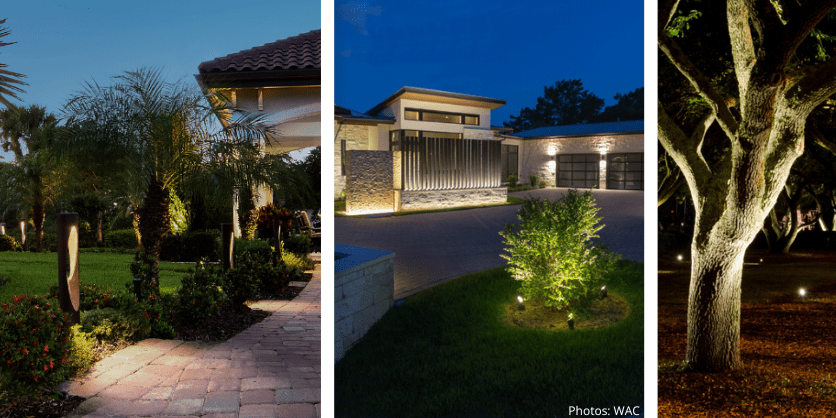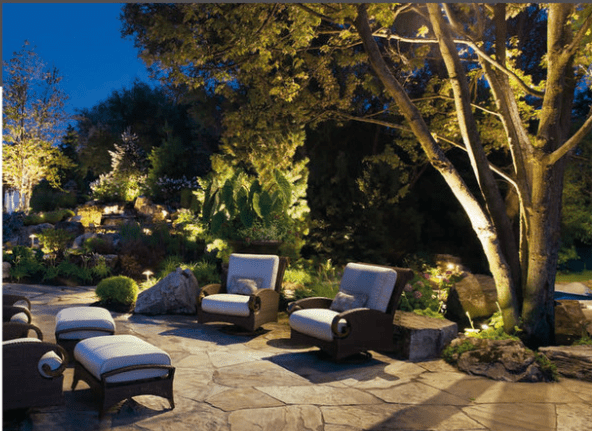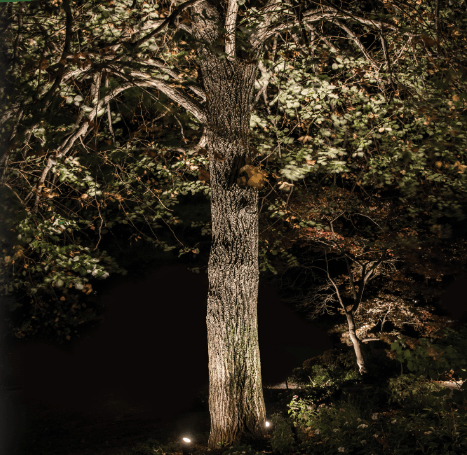Continuing Series: How to Use Warm & Cool Light to Create Atmosphere in Landscapes

By Robert Lanteigne
Landscape lighting is more than a tool for visibility; it’s an art that shapes the emotional and aesthetic feel of outdoor spaces. One of the most powerful ways to influence mood and functionality in a garden or yard is through color temperature, which refers to the warmth or coolness of light. By understanding the effects of warm versus cool lighting, you can create an inviting or energizing atmosphere, highlight specific plants, and even enhance the security of your home.
This article delves into how choosing the right color temperature can create different moods, encourage plant health, and offer security benefits. Let’s explore how lighting can transform an outdoor space from the cozy ambiance of warm lighting to the crisp, modern aesthetic of cool tones.
Warm Lighting = Cozy & Inviting
Warm lighting has a color temperature of around 2700K to 3000K, producing a soft, golden glow that mirrors the warmth of a sunset or a cozy fire. This kind of lighting is ideal for spaces where relaxation and intimacy are key goals. In outdoor settings, patios, decks, and seating areas benefit from this inviting glow, making these spaces perfect for winding down after a long day or for social gatherings under the stars.

Warm lighting is especially effective in areas where you want people to feel comfortable and welcome. Think of it as the lighting equivalent of a cozy blanket: it softens the surroundings, encouraging people to linger and enjoy the ambiance. Additionally, this golden hue complements natural textures like wood and stone, highlighting their earthy tones. When used near plants, warm lighting creates a natural, sunset-like effect that enhances the colors and textures of leaves and flowers, giving them a rich, vibrant appearance even after dark.
Making Warm Colors Pop
The warm hues of outdoor lighting can also make specific colors pop — especially reds, oranges, and yellows, which are naturally enhanced by warmer light. If your garden includes plants with bold colors, such as marigolds, red-leafed trees, or flowering bushes, positioning warm lights nearby will accentuate their beauty. Flowers and foliage take on a rich, almost magical quality, creating focal points that draw the eye and deepen the sense of coziness.
By thoughtfully placing warm lighting near flowering plants, you can turn blooms into “divas” of the garden, giving them the starring role as the light captures their colors and textures. For added impact, consider using spotlights on specific plants or clusters, as the directed beam will create a striking effect that draws attention to the colors and shapes of the leaves and petals.
Cool Lighting = Crisp & Modern
In contrast to warm lighting, cool lighting has a higher color temperature, usually above 4000K. This type of lighting creates a crisp, energizing atmosphere that is ideal for areas where clear visibility is important, such as driveways, pathways, and entrances. Cool light has a bright, clean look that enhances a modern or minimalist aesthetic, making it a popular choice for contemporary homes and gardens.
Cool lighting also works well to highlight sleek architectural elements, such as metal railings, concrete steps, or geometric sculptures, creating a sophisticated, polished appearance. The clean tone of cool lighting adds clarity and sharpness, making outdoor spaces feel more open and expansive. This quality makes it particularly effective for lighting pathways and driveways, where safety is key, and the clear, bright light allows for easy navigation.
Enhancing Security With Cool Lighting
Beyond its aesthetic benefits, cool lighting serves a practical role in security. The increased visibility offered by cool-toned lighting helps deter unwanted visitors by illuminating potential hiding spots and making the perimeter of your property more visible. By using cool lighting along fences, pathways, and driveways, you can increase safety and security around your home without compromising style.
For added security, consider using motion-activated cool lighting near entryways and in areas that may benefit from added surveillance. This type of lighting not only surprises and discourages potential intruders but also provides efficient illumination only when it’s needed.
Balancing Warm & Cool Light
To achieve a harmonious atmosphere, combining warm and cool lighting creates zones of varied energy and purpose. For instance, using warm lighting in seating areas and cool lighting along pathways creates a layered effect that guides guests naturally through the space while subtly highlighting different areas. This approach provides both a welcoming ambiance and functional lighting, balancing areas for relaxation with areas where visibility and safety are more important.
When planning your lighting design, consider the different zones you want to create in your outdoor space. Areas for dining, lounging, and entertaining are well-suited to warm light, as it draws people in and promotes a sense of comfort. Pathways, driveways, and other areas where clarity is essential will benefit from cool lighting, helping visitors safely navigate the space. By balancing these color temperatures, you create a cohesive lighting plan that meets both aesthetic and practical needs.
The Role of Lighting in Nighttime Photosynthesis
Interestingly, outdoor lighting can also have subtle effects on plant health, especially with regard to photosynthesis. While plants rely primarily on sunlight for their growth, certain wavelengths of artificial light can have an impact on their nighttime processes. Warm lighting, with its more natural amber tones, tends to have a lower impact on plant activity. This is because plants are generally more sensitive to blue light, which is more common in cooler, higher-temperature lighting.

If you have delicate or exotic plants in your garden that require specific care, it’s best to limit the use of cool lighting around them, as it may slightly disrupt their natural processes. Instead, opting for warmer light can create a visually appealing garden that respects the natural rhythms of your plants. Additionally, consider installing low-intensity lights near flower beds or shrubs to minimize any interference with plant growth cycles.
Seasonal Interaction of Light With Landscape
One of the most rewarding aspects of using color temperature in landscape lighting is the way it interacts with the changing seasons and the natural features in your garden. For instance, in spring, the blossoming flowers and vibrant new leaves are complemented beautifully by warm lighting, which brings out the freshness of their colors. As summer unfolds, the dense greenery provides a lush backdrop that diffuses light, softening the ambiance and creating a soothing environment.
In autumn, as leaves begin to change color, warm lighting enhances the reds, oranges, and yellows, making these seasonal hues even more vivid. When winter arrives and trees lose their foliage, cool lighting highlights the intricate silhouettes of bare branches, turning them into striking winter displays. This seasonal interplay between light and natural elements adds a dynamic quality to your garden, ensuring that the landscape feels fresh and engaging throughout the year.
Using Lighting to Emphasize Plant Features and Foliage
The textures, colors, and shapes of plants provide endless opportunities for creative lighting. Uplighting tall trees, for example, casts dramatic shadows and adds height to the scene. Placing lights at the base of a tree and aiming them upward will highlight the texture of the bark and the shape of the branches, creating a sense of depth and dimension in the landscape.

Bushes and shrubs, with their varied heights and densities, can also be transformed through lighting. For denser bushes, gentle lighting from below creates an enclosed, cozy space, while smaller or more open shrubs allow light to pass through, casting delicate patterns on the ground. By experimenting with the placement and intensity of warm and cool lighting, you can emphasize the natural beauty of each plant, creating an outdoor environment that feels alive and layered.
The Emotional & Aesthetic Impact of Color Temperature
Ultimately, color temperature is a powerful tool for shaping the emotional tone of your outdoor space. Warm lighting fosters a sense of comfort, encouraging relaxation and intimacy, while cool lighting creates a modern, refined atmosphere. By combining these two approaches, you can design an outdoor environment that feels both welcoming and versatile.
Beachfront Houses
For homes near the beach, where sea turtles are part of the ecosystem, lighting choices are especially important to protect these sensitive creatures. Sea turtles rely on the natural glow of the moon to navigate from the beach to the ocean, so artificial lighting can disrupt this critical journey, particularly during nesting season. Turtle-friendly lighting – typically amber or red in color with low-intensity and downward-focused fixtures – minimizes disruption to sea turtles by reducing the light wavelengths that affect them most. If you live near turtle habitats, choosing fixtures with shields to direct light away from the beach and using warm, low-output bulbs helps ensure a safe, natural environment for these incredible animals.
About the Author

Robert Lanteigne, also known as Lightbob, is a visionary entrepreneur, artist, electrician, and mentor, originally from Montreal and now based in Florida. With decades of experience, he has built an impressive career in lighting design and creative coaching, working with architects, engineers, and designers around the world. As the founder and CEO of Lightbob.com, Robert leads a globally recognized lighting design company, delivering innovative solutions to clients worldwide.
Bob’s exceptional expertise in lighting design has made him a renowned figure in the industry. His work has been featured in prestigious publications such as Architectural Digest and Interior Design, and he is a frequent speaker at major industry events globally. A former member of the International Association of Lighting Designers, Bob is now an active member of the Lighting Agora, solidifying his lasting influence on the lighting design community.
Related articles
New Series: The Non-Technical Language of Landscape Lighting
The Art and Hardware of Lighting: Finding Beauty in Function







